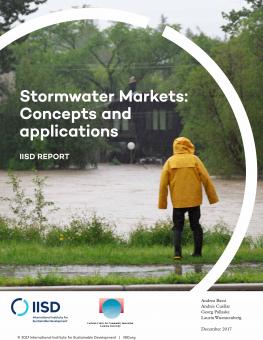
Stormwater Markets: Concepts and applications
This paper provides an overview of the technology and financing options available to address the stormwater problem in urban areas. The analysis focuses on policy instruments for incentivising private investments into green infrastructure, specifically through the creation of stormwater markets.
This paper provides an overview of the technology and financing options available to address the problem and better plan for stormwater market management. Specifically, the analysis focuses on the creation of stormwater markets.
Finding solutions to the stormwater problem is critical. Urban areas are rapidly expanding, climate variability is increasing, and social and environmental impacts are becoming more difficult to anticipate and more expensive to fix. In addition, funds are simply not available from the public sector to meet the increasing needs for capital and operation and maintenance costs of water management infrastructure.
Instead of targeting the management of stormwater runoff by centralized, end-of-pipe and capital-intensive gray infrastructure, green infrastructure aims to increase surface infiltration and lower the amount of stormwater at the source. Green infrastructure requires interventions by land and property owners, representing a decentralized approach to stormwater management. While investments would take place primarily on private property, the benefits of such interventions would be felt by many. As a result, the economics of the investment have not made these interventions very popular in the past. Policy support is needed to stimulate private investments.
The vast majority of empirical cases are examples of policy implementation (either individual policies or a portfolio of options), but the implementation of stormwater markets is also on the rise. These represent a quantity-based approach, with a set number of allowances, normally declining over time. Available options include credit trading and the creation of a mitigation bank. Various additional mechanisms can be used to create incentives for investments in stormwater management. Examples include in-lieu fees, permittee-responsible mitigation (offsets) and a combination of policy instruments.
The opportunities emerging from the establishment of stormwater markets are considerable, especially when considering the potential social, economic and environmental impacts. To obtain such benefits, and in light of the design and implementation challenges identified, a customized approach is required. This would ensure that the market is designed to create synergies with existing legal frameworks and generate enough buy-in to work effectively for a variety of economic actors, a key requirement to reach scale.
Participating experts
You might also be interested in
Sustainable Asset Valuation of Parques del Río Norte in Medellín, Colombia
This economic valuation demonstrates the benefits of expanding urban green space in the city of Medellín, Colombia.
A Sustainable Asset Valuation Assessment of Building and Transport Infrastructure Investment in the Shymkent-Tashkent-Khujand Economic Corridor
This report presents the Sustainable Asset Valuation (SAVi) of a proposed transport and building infrastructure development on the border of Kazakhstan and Uzbekistan to promote close and mutually beneficial trade relationships between the countries.
We need more natural infrastructure, and fast
While natural infrastructure alone could not have prevented the Red River spill, a well-funded hybrid system of grey and natural infrastructure will help mitigate the impacts of such disasters, and help prevent them happening again in the future, as well as support the Canadian environment, and the economy.
Monitoring Progress in Green Public Procurement
This report outlines the importance of monitoring progress in green public procurement (GPP) and highlights various methodologies, challenges, and recommendations.